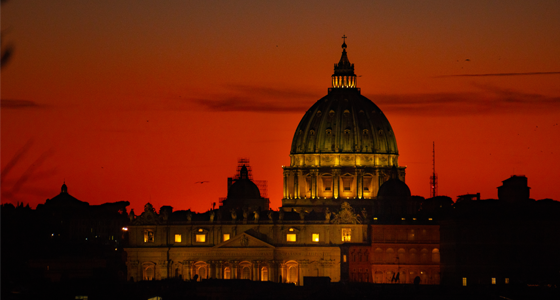Vatican II: Taking on the Threats of Modernism, Relativism, and Neo-Paganism

The Second Vatican Council was the first ecumenical council in nearly a century and was the most attended ecclesial gathering in Church history. Its business was conducted over four sessions from October 1962 to December 1965; however, the man behind the vision of the council died in the summer of 1963 after the conclusion of the first session and there was serious discussion over whether it should continue. His successor Pope Paul VI (r. 1963-1978) quickly silenced the question concerning the council’s continuation by revising its statutes and outlining an agenda for its future sessions. All told, the council produced sixteen documents, among which were four major constitutions.
Recognizing the evils of Modernism and the societal revolution produced by its fruits, the council urged the lay faithful to take an active role in the Church’s mission. The laity have a unique opportunity to evangelize and make present the Church in “those places and circumstances where only through them can it become the salt of the earth” (Lumen Gentium, 33). In a secular and post-Christian world, the laity are given the special task to bring the light of Christ to those in the darkness, especially where modernity rejects organized religion and the power and authority of institutional churches. It is primarily through authentically expressed Christian witness that the laity can accomplished this special task. Modernism produces spiritual hunger, as people discover that neo-pagan principles do not satisfy their souls. In the dictatorship of relativism, modern man does not find answers to life’s deepest questions. The world was ready for the truth of Christ witnessed afresh.
In its Decree on the Apostolate of the Laity (Apostolicam actuositatem), the Council urged the laity to be true apostles who look “for opportunities to announce Christ by words addressed either to non-believers with a view to leading them to faith, or to the faithful with a view to instructing, strengthening, and encouraging them to a more fervent life” (6). The Dogmatic Constitution on the Church, Lumen Gentium, stressed that the fundamental call to holiness applies to all the faithful, regardless of vocation, and that the task of evangelization and catechesis is the purview of all the baptized, not just the clergy. In order to effectively participate in these endeavors and provide a witness to modern people, the faithful must know, live, and transmit the faith in accordance with their vocation. The council fathers urged the laity to utilize culture, media, and, particularly, their role in the procreation and education of children to renew the Church and civilization. They highlighted certain activities of the lay apostolate, such as the adoption of abandoned infants, marriage preparation, support for those in material and moral crises, and education, as vital tasks in the modern world (Apostolicam actuositatem 11). These tasks and the important role of the laity were further developed in the Pastoral Constitution on the Church in the Modern World (Gaudium et Spes).
This document was not only a response to Modernism but also was a clarion call to the Church and its faithful to actively engage modernity through the presentation of the Gospel and authentic Christian witness, noting that “the council yearns to explain to everyone how it conceives of the presence and activity of the Church in the world of today” (2). Gaudium et Spes first explicated the Church’s teachings on the dignity of the human person, the call to communion with God, and the law of gift whereby man only finds himself through a sincere gift of self to another. These teachings are the antidote to offenses against human dignity prevalent in the modern world, such as genocide, abortion, euthanasia, torture, slavery, prostitution, human tracking, and utilitarianism. Catholics were not to sit idle or become insular when faced with the problems of modernity but must take an active role in combating them by being engaged in the world and living the Faith in the public arena. The pernicious error, increasingly embraced by Catholic politicians of the day, of separating one’s faith from public life was condemned. Instead, the fathers encouraged all Catholics, and especially those occupying public office, to a unity of faith and life.
Gaudium et Spes also drew attention to two related areas of extreme important to the laity: marriage and family. The family, which is the foundational cell of society, faced grave danger in the modern world. Belief that God is the author of marriage and in the twofold purpose of marriage (good of the spouses and the procreation and education of children) was under considerable assault from modern forces. The growing availability and use of contraception and abortion posed a unique new danger for the health and stability of human society. As a result, Catholics were to work to preserve laws that safeguard marriage and the family and labor diligently to overturn those that sought to destroy it.
The Church’s focus in this area continued after the council when Pope Paul VI promulgated an encyclical on the subject of married love and the transmission of life. Known as Humanae Vitae, the papal document reiterated the constant teaching of the Church concerning the truth and beauty of human sexuality in the midst of great societal and culture change. Issued during the midst of the Sexual Revolution, which sought to destroy Christian virtue and morality, Humanae Vitae emphasized the unique mission entrusted by God to married couples: to bring forth new human life as co-creators with him. At a time when the advent of the birth control pill, the ongoing shift from agrarian to industrial economies, and the relativism and dualism that accompanied Modernism were leading observers to predict that the Church would overturn its longstanding teaching on the integrity of sexual acts, Paul VI doubled down on it. Even as other Christian groups were abandoning their past prohibitions of contraception, with Humanae Vitae the Church affirmed that “each and every marital act must remain open to the transmission of life” (11).
Did you enjoy this excerpt from Steve Weidenkopf's new book?
You can now order your copy of Light From Darkness: Nine Times the Church was in Turmoil, and Came Out Stronger Than Before, the newest release from Catholic Answers Press.
Recent Posts
-
God Creates Out of Love
God creates, we believe, ex caritate—out of love. If we recall our image of Christianity as a refle …Dec 16th 2025 -
If We Just Love Jesus, Does It Really Matter Which Church We Go To?
When I was considering joining the Catholic Church, I sat down with some of my non-Catholic friends …Dec 12th 2025 -
How Can I Prepare Myself to Receive Holy Communion at Mass More Fruitfully?
Preparation for the celebration of the holy Mass and reception of Holy Communion is an essential el …Dec 8th 2025









